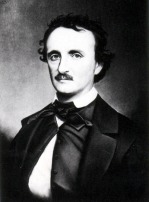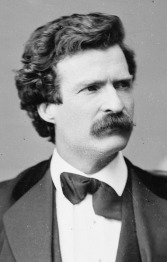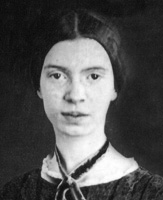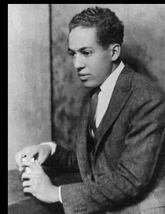Author to study Unit : Edgar Allan Poe

Edgar Allan Poe, son of Actress Eliza Poe and Actor David Poe Jr., born 19th of January 1809, was mostly known for his poems and short tales and his literary criticism. He has been given credit for inventing the detective story and his pshycological thrillers have been infuences for many writers worldwide. Edgar and his brother and sister were orphaned before Edgar's third birthday and Edgar was taken in to the home of John and Fanny Allan in Richmond, Va. In 1827 Edgar published his first book, "Tamerlane and other poems" anonymously under the signature "A Bostonian". The poems were heavily influenced from Byron and showed of a youthful attitude. Later in 1827 Edgar enlisted in the Army under the name Edgar A Perry where his quarrels with John Allan continued. Edgar did well in the army but in 1829 he left and decided to apply for a cadetship at West Point. Before he was able to enter West Point Edgar published a book entitled "Al Aaraaf, Tamerlane, and minor poems", this time the book was published, not anonymously, but under the name Edgar A. Poe, where the middle initial acknowledged John Allan's name. Before Edgar left West Point he received financial aid from his fellow cadets to publish a third edition of the book. Edgar called it a second edition though and it was entitled "Poems by Edgar A. Poe" in which his famous poems "To Helen" (another version was published in 1848) and "Israfel" appeared. In 1832 he won a $50 prize for his story "MS. Found in a Bottle" in the Baltimore Saturday Visiter. He also married his cousin Virginia, only thirteen years old. Most of Edgar's work with the Messenger were of a critical nature but he also published some literary work such as"Berenice". His theories on musical poems and short prose narratives which were to aim at "a certain unique or single effect" can be for example be seen in "Ligeia"(1838) and THE FALL OF THE HOUSE OF USHER (1839) which would eventually become one of his most famous stories. "The Murders in the Rue Morgue" (1841) is sometimes considered the first detective story. Examples of his use of a rythmic and flowing language are the poems "The Raven" (1845) and "The Bells" (1849). The Raven was a symbol of "Mournful and never ending remembrance" which is not only a good description for "The Raven" but could be applied to almost all of his work. In January 1847 Virginia Died and Edgar took this very hard but he kept on writing until the day he died in Baltimore October 7, 1849.
Author study Unit : Mark Twain

On Nov. 30, 1835, the small town of Florida, Mo. witnessed the birth of its most famous son. Samuel Langhorne Clemens was welcomed into the world as the sixth child of John Marshall and Jane Lampton Clemens. At 17, he left Hannibal behind for a printer's job in St. Louis. While in St. Louis, Clemens became a river pilot's apprentice. He became a licensed river pilot in 1858. Clemens' pseudonym, Mark Twain, comes from his days as a river pilot. It is a river term which means two fathoms or 12-feet when the depth of water for a boat is being sounded. "Mark twain" means that is safe to navigate. Because the river trade was brought to a stand still by the Civil War in 1861, Clemens began working as a newspaper reporter for several newspapers all over the United States. In 1870, Clemens married Olivia Langdon, and they had four children, one of whom died in infancy and two who died in their twenties. Their surviving child, Clara, lived to be 88, and had one daughter. Clara's daughter died without having any children, so there are no direct descendants of Samuel Clemens living. Twain began to gain fame when his story, "The Celebrated Jumping Frog of Calavaras County" appeared in the New York Saturday Press on November 18, 1865. Twain's first book, "The Innocents Abroad," was published in 1869, "The Adventures of Tom Sawyer" in 1876, and "The Adventures of Huckleberry Finn" in 1885. He wrote 28 books and numerous short stories, letters and sketches. Mark Twain passed away on April 21, 1910, but has a following still today. His childhood home is open to the public as a museum in Hannibal, and Calavaras County in California holds the Calavaras County Fair and Jumping Frog Jubilee every third weekend in May. Walking tours are given in New York City of places Twain visited near his birthday every year.
Author to Study Unit 5: Emily Dickinson

Emily Dickinson was born in Amherst, Massachusetts, in 1830. By the 1860s, Dickinson lived in almost total physical isolation from the outside world, but actively maintained many correspondences and read widely. She spent a great deal of this time with her family. Her father, Edward Dickinson, was actively involved in state and national politics, serving in Congress for one term. Her brother Austin attended law school and became an attorney, but lived next door once he married Susan Gilbert. Dickinson’s younger sister Lavinia also lived at home for her entire life in similar isolation. Lavinia and Austin were not only family, but intellectual companions during Dickinson’s lifetime.Dickinson's poetry reflects her loneliness and the speakers of her poems generally live in a state of want, but her poems are also marked by the intimate recollection of inspirational moments which are decidedly life-giving and suggest the possibility of happiness. Her work was heavily influenced by the Metaphysical poets of seventeenth-century England, as well as her reading of the Book of Revelation and her upbringing in a Puritan New England town which encouraged a Calvinist, orthodox, and conservative approach to Christianity. She admired the poetry of Robert and Elizabeth Barrett Browning, as well as John Keats. While Dickinson was extremely prolific as a poet and regularly enclosed poems in letters to friends, she was not publicly recognized during her lifetime. The first volume of her work was published posthumously in 1890 and the last in 1955. She died in Amherst in 1886. Upon her death, Dickinson's family discovered 40 handbound volumes of nearly 1800 of her poems, or "fascicles" as they are sometimes called. The handwritten poems show a variety of dash-like marks of various sizes and directions. The poems were initially unbound and published according to the aesthetics of her many early editors, removing her unusual and varied dashes and replacing them with traditional punctuation.
Author to Study Unit 6: Langston Hughes

Born in Joplin, Missouri, James Langston Hughes was a member of an abolitionist family. Hughes attended Central High School in Cleveland, Ohio, but began writing poetry in the eighth grade, and was selected as Class Poet. His father didn't think he would be able to make a living at writing, and encouraged him to pursue a more practical career. His first published poem was also one of his most famous, "The Negro Speaks of Rivers", and it appeared in Brownie's Book. Later, his poems, short plays, essays and short stories appeared in the NAACP publication Crisis Magazine and in Opportunity Magazine and other publications.One of Hughes' finest essays appeared in the Nation in 1926, entitled "The Negro Artist and the Racial Mountain". Through these experiences a new rhythm emerged in his writing, and a series of poems such as "The Weary Blues" were penned.In the forty-odd years between his first book in 1926 and his death in 1967, he devoted his life to writing and lecturing. He wrote sixteen books of poems, two novels, three collections of short stories, four volumes of "editorial" and "documentary" fiction, twenty plays, children's poetry, musicals and operas, three autobiographies, a dozen radio and television scripts and dozens of magazine articles. In addition, he edited seven anthologies. The long and distinguished list of Hughes' works includes: Not Without Laughter (1930); The Big Sea (1940); I Wonder As I Wander" (1956), his autobiographies. His collections of poetry include: The Weary Blues (1926); The Negro Mother and other Dramatic Recitations (1931); The Dream Keeper (1932); Shakespeare In Harlem (1942); Fields of Wonder (1947); One Way Ticket (1947); The First Book of Jazz (1955); Tambourines To Glory (1958); and Selected Poems (1959); The Best of Simple (1961). He edited several anthologies in an attempt to popularize black authors and their works. Some of these are: An African Treasury (1960); Poems from Black Africa (1963); New Negro Poets: USA (1964) and The Best Short Stories by Negro Writers (1967).Published posthumously were: Five Plays By Langston Hughes (1968); The Panther and The Lash: Poems of Our Times (1969) and Good Morning Revolution: Uncollected Writings of Social Protest (1973); The Sweet Flypaper of Life with Roy DeCarava (1984).Langston Hughes died of cancer on May 22, 1967. His residence at 20 East 127th Street in Harlem, New York has been given landmark status by the New York City Preservation Commission. His block of East 127th Street was renamed "Langston Hughes Place".Biography by: Andrew P. Jackson (Sekou Molefi Baako)
